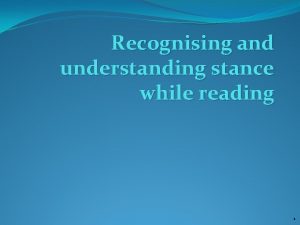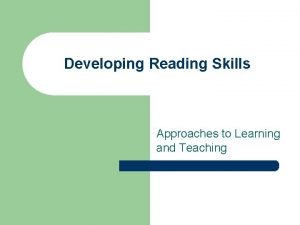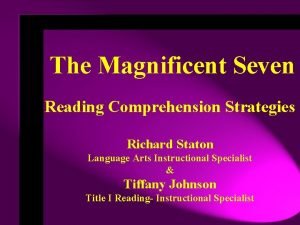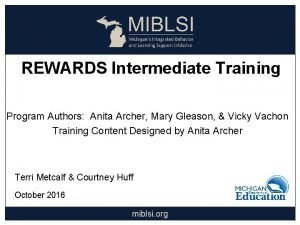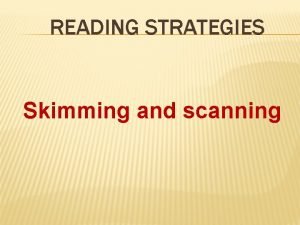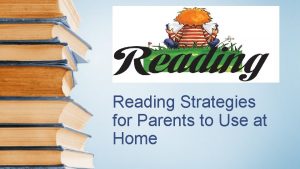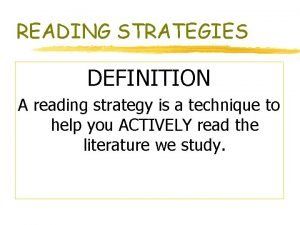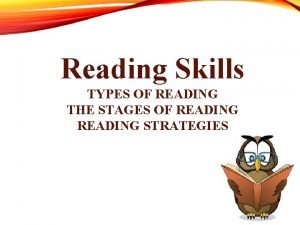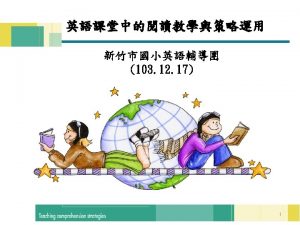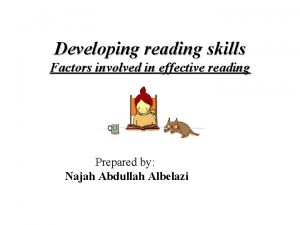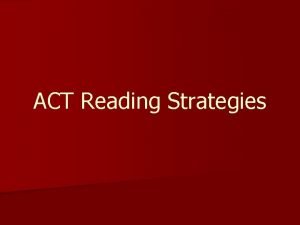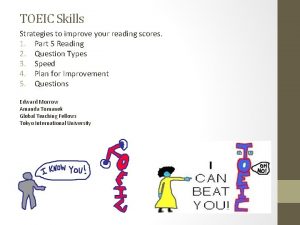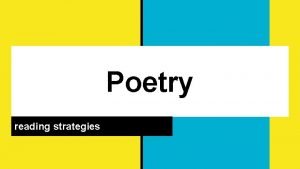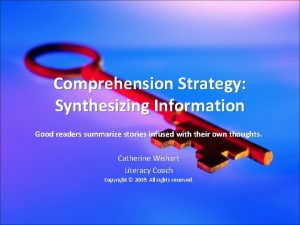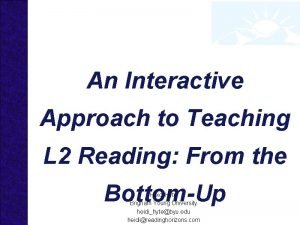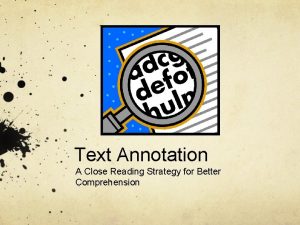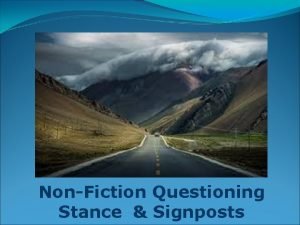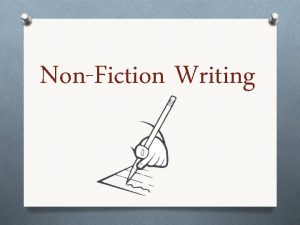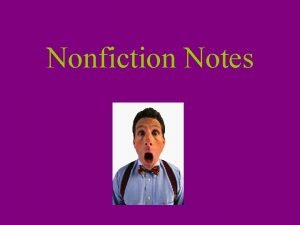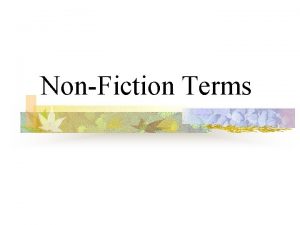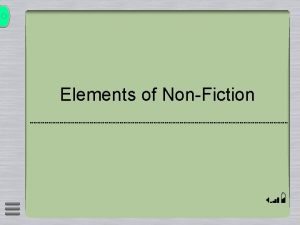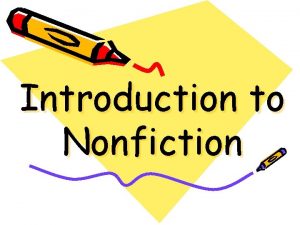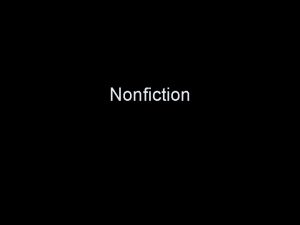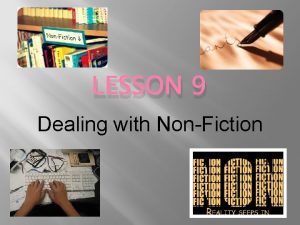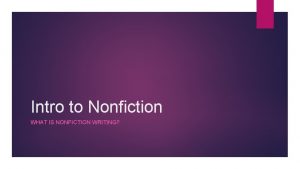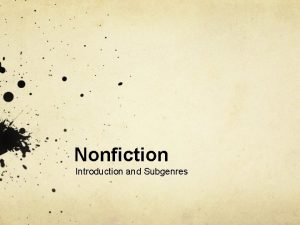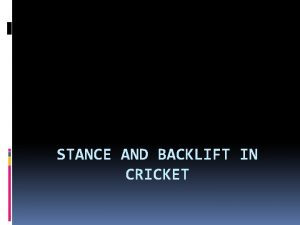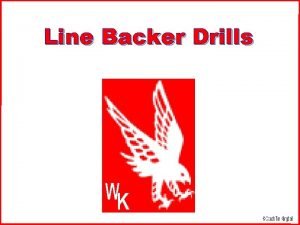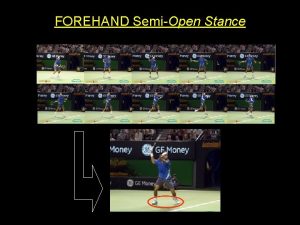NONFICTION READING STRATEGIES THE IMPORTANCE OF STANCE q


















- Slides: 18

NON-FICTION READING STRATEGIES

THE IMPORTANCE OF STANCE q. Fiction- We know it’s false, but it still invites us to take a stance. q. We love it, or we leave it. q. We “got lost in the story”. q. Nonfiction makes an assertion (a theory, a perspective) about something in the world. q. They may be true. q. They may be biased. q. They may be lies. q. Getting “lost in the story” may be a problem. q. So… We’re going to use the QUESTIONING STANCE.

QUESTIONING STANCE ØWhat is the purpose of this article? ØWhat surprised me? ØWhat did the author think I already knew? ØWhat changed, challenged, or confirmed what I already knew?

WHAT IS THE AUTHOR’S PURPOSE? ØAuthor’s write for many purposes… ØTo EXPRESS a feeling or REFLECT on life. ØTo INFORM readers about something and to EXPLAIN ideas. ØTo EVALUATE whether something is good and to judge its strengths and weaknesses. ØTo ANALYZE and to INTERPRET parts of it to make meaning. ØTo TAKE A STAND & PERSUADE ØTo ENTERTAIN ØThis helps us identify if we’re being manipulated or not.

WHAT SURPRISED ME? v. Creates an active reader (harder to get lost & distracted). v. Expect to be surprised. v. Search for what is new. v. Helps us identify our prior knowledge and causes us to actively question whether we can accept this new information. v. What makes you say… v“Really? ” v “I didn’t know that!” v “Oh, now I get it!” v “I hadn’t thought of it that way. ” Or “I there another way to see this? ”

WHAT DID THE AUTHOR THINK I ALREADY KNEW? v. When you find yourself confused… who answers your problem? v. YOU! v. You are empowered to find and fix the problem. v. Practical and useful for your entire future. v. What makes you say… v“I did not know…” v“I was confused by…” v“The author assumed…” v“The author thought I knew…” v“The author thought I could visualize …” v. Terms, processes, historical information, other background knowledge

WHAT CHALLENGED, CHANGED OR CONFIRMED WHAT I ALREADY KNEW? v. Internet problem (who do we trust? ) v. This links us to PRIOR KNOWLEDGE: v. RED FLAGS? v. EXPAND on what you know? v. Helps you CONNECT with new knowledge v. Most often, it won’t drastically change your thinking. v. It may modify (change) it in some way. v. It also helps us identify things that may not be true.

WHAT CHALLENGED, CHANGED OR CONFIRMED WHAT I ALREADY KNEW? v. At first I thought… but… v. I had to rethink… v. My understanding changed when… v. I was right/wrong about… v. Example: You read an article about global warming. v. How do you feel about global warming? v. Did it change your opinion/ideas about global warming? v. Was there any information you need to confirm? v. What if your parents are global warming experts?

QUESTIONING STANCE ØWhat is the purpose of this article? ØWhat surprised me? ØWhat did the author think I already knew? ØWhat changed, challenged, or confirmed what I already knew?

NON-FICTION SIGNPOSTS o. Contrasts and Contradictions o. Extreme or Absolute Language o. Numbers and Stats o. Quoted Words

CONTRASTS & CONTRADICTIONS • What is it? • It is when you notice a DIFFERENCE between what YOU KNOW, think, or have experienced and what is presented OR you notice a DIFFERENCE between two or more things IN THE TEXT. • ASK: What is the difference and why does it matter? • Example? • You know that babies benefit from being read to at least once a day. • You read an article that says that babies don’t understand, so reading is a waste of time.

EXTREME OR ABSOLUTE LANGUAGE • What is it? • You notice the author uses words or phrases that leave NO DOUBT, EXAGGERATE, or OVER STATES a case. • ASK: Why did the author say it like that? • Clues: all, everything, none, nothing, completely, (and size words): huge, massive, tiny, enormous…etc. • Can you think of an example of someone or a situation where extreme or absolute language is used?

NUMBERS OR STATS §What is it? §The author uses numbers (2 or two) or words (several, a lot, few) that show amounts or statistical information to show COMPARISON. Often to PROVE A POINT or CREATE AN IMAGE. §ASK: Why did the author use these numbers or amounts? §Clues: 1, 2, 3, … percent, percentage, ratio, rate, polls, miles, kilometers, inches, feet, yards, etc. §EXAMPLE: When would the news use a number to prove a point?

QUOTED WORDS v. What is it? v. When you notice the author quotes others, a voice of authority (“experts”), a personal perspective (opinion or experience), or someone else’s words. v. ASK: Why did the author quote or cite this person? How does it help their argument? v. Clues: According to, in a study, and other quotes (watch for indented block quotes). v. What benefit would quoting someone else bring to an author? OR Why quote someone else in when writing something?

NON-FICTION SIGNPOSTS REVIEW o. Contrasts and Contradictions o. Extreme or Absolute Language o. Numbers and Stats o. Quoted Words

QUESTIONING STANCE ØWhat is the purpose of this article? ØWhat surprised me? ØWhat did the author think I already knew? ØWhat changed, challenged, or confirmed what I already knew?

WHAT IS THE AUTHOR’S PURPOSE? ØAuthor’s write for many purposes… ØTo EXPRESS a feeling or REFLECT on life. ØTo INFORM readers about something and to EXPLAIN ideas. ØTo EVALUATE whether something is good and to judge its strengths and weaknesses. ØTo ANALYZE and to INTERPRET parts of it to make meaning. ØTo TAKE A STAND & PERSUADE ØTo ENTERTAIN ØThis helps us identify if we’re being manipulated or not.

WHAT IS YOUR “JOB” AS READER? ØThe author of any article is trying to teach you something about your world. ØYour job is to… ØDetermine the author’s purpose for writing ØGather and extract the key information ØDetermine should I accept or reject it? ØThese strategies and stance questions help you to make that determination.
 Reading stance
Reading stance Reading stance
Reading stance Pre reading while reading and post reading activities
Pre reading while reading and post reading activities Nonfiction reading test black friday
Nonfiction reading test black friday Seven reading strategies
Seven reading strategies Rewards reading program training
Rewards reading program training What is scanning reading?
What is scanning reading? Reading strategies for parents to use at home pdf
Reading strategies for parents to use at home pdf Reading strategy
Reading strategy Types of readers
Types of readers Super 6 reading strategies
Super 6 reading strategies What is reading
What is reading What are the six active reading strategies
What are the six active reading strategies Act reading strategies
Act reading strategies Taking the toeic skills and strategies 1
Taking the toeic skills and strategies 1 Poetry reading strategies
Poetry reading strategies Reading comprehension synthesizing
Reading comprehension synthesizing Top down approach reading
Top down approach reading What is text annotation
What is text annotation

